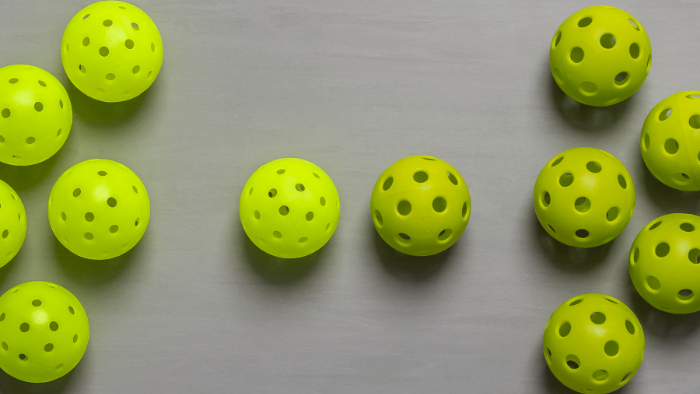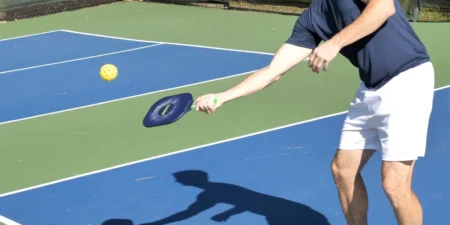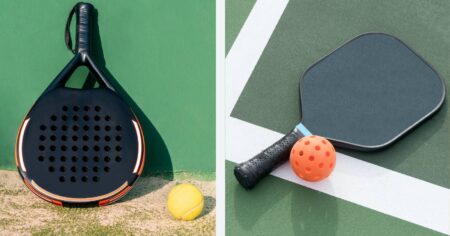
Pickleballs come in a variety of varieties based on their intended usage, degree of competition, or amount of enjoyment. They are constructed of hard plastics, resins, or polymers. The appropriate kind of ball improves the game, whilst the wrong kind could make you frustrated.
Outdoor balls are larger, tougher, and more impact- and wind-resistant than indoor balls. Indoor balls have various properties. While easier to handle, softer materials do not travel as quickly or far as tougher ones. Selecting the ideal pickleball for your game requires a thorough understanding of these elements.
At the end of this article you will be well aware of what is a pickleball made of.
What Is A Pickleball Made Of
A pickleball is a specialized sports ball used in the game of pickleball that was created to be resilient and durable despite regular use, hits, and quick movements.
For better control and precision indoor pickleballs are composed of softer materials, whereas outdoor pickleballs are constructed of stronger resins and plastics for increased longevity and better performance in challenging situations.
The formal specifications for a pickleball include the absence of texturing, a set number of holes, a circular shape for the holes, and adherence to established criteria. These requirements guarantee the game’s fairness and consistency, providing consistent bounce and playability.
The regular shape, standard number, and smooth surface of a pickleball court are important characteristics. To avoid affecting the performance of the ball, logos and branding must also adhere to the rules set forth by the authorities.
What Indoor Pickleballs Made Of
Indoor pickleballs have a softer, smoother surface that resembles wooden gym floors and are made specifically for the atmosphere and playing circumstances of indoor courts. These pickleballs have special features designed to improve their performance indoors.
Material And Durability:
Compared to outdoor pickleballs, indoor pickleballs are lighter and softer, protecting the quality of the ball and the court. They have about 26 fewer holes, which affects the ball’s flight characteristics.
Size And Bounce:
Indoor pickleballs are a little bigger than those used outdoors, giving players more control on serves and rallies. In indoor pickleball matches, the decreased bounce encourages longer volleys and an additional layer of strategy.
Weight:
Indoor pickleballs are slightly lighter than outdoor balls, weighing about 0.8 ounces (22.68 grams). The play style is influenced by the reduced weight and demands dexterity and accuracy.
While some players might enjoy the more manageable gameplay and smaller weight, others might find it lacking in power, particularly for outside play. Indoor pickleball courts are a popular option for many aficionados because they are less likely to shatter over time, even though they may eventually soften.
However, due to its reduced weight, vulnerability to wind, and quicker wear and tear on harsher surfaces like concrete or asphalt, outside use is not advised.
What Outdoor Pickleball Made Of?
Pickleballs designed for outdoor play are specifically made to survive the rigors of outside play, where they are exposed to harsher surfaces and a variety of weather conditions. They are the best option for outdoor pickleball courts, such those found on tennis courts and other rougher outdoor surfaces, due to their distinctive qualities.
Material And Durability:
Pickleballs used outdoors are made of much heavier plastic that is also very durable. Due to their sturdy design, they are guaranteed to last despite the challenging outdoor circumstances they are exposed to, such as UV rays, wind, and abrasive surfaces.
Weight:
The average outdoor pickleball weighs about 0.9 ounces (25.51 grams), which is only marginally more than the indoor version. However, this minor weight gain has a significant effect on the game, boosting the force and intensity of shots.
The added weight also increases the outdoor pickleball’s resistance to wind’s effects, allowing for a more predictable trajectory while playing.
Speed And Sound:
When compared to indoor balls, outdoor pickleballs are noted to be faster, louder, and have a stronger “pop.” The audio feedback heightens the thrill of outdoor play and may be especially alluring to players who appreciate the competitive nature of the game.
Hole Configuration:
Compared to indoor pickleballs, which have 26 holes, outdoor pickleballs frequently have additional holes around 40, on average. The ball’s performance on outdoor courts is aided by these holes, which are typically smaller and more numerous.
Use On Indoor Courts:
Although outdoor pickleballs are made for outside use, indoor courts are less suited to their use because of their heavier build and propensity for noise. Outdoor pickleballs may wear out faster and crack more frequently than indoor pickleballs due to the harder, rougher surface of indoor courts.
They are perfect for stressful and frantic outdoor matches because of their sturdy and hefty plastic structure, greater weight, recognizable sound, and improved speed. Although players often choose indoor pickleballs for indoor court environments, their strong build may not be ideal for indoor play.
Conclusion
A pickleball is a specialized sports ball designed for resilience and durability. Indoor pickleballs are made of softer materials, while outdoor pickleballs are made of stronger resins and plastics for increased longevity and performance in challenging situations.
Indoor pickleballs have a softer, smoother surface resembling wooden gym floors and are designed for indoor courts. They are lighter, softer, and have fewer holes, allowing players more control on serves and rallies.
Outdoor pickleballs weigh slightly more, but this minor weight gain boosts the force and intensity of shots. They also have a stronger “pop” and faster, louder, and louder sound. Outdoor pickleballs are more suitable for indoor courts due to their heavier build and noise-prone nature.
Indoor pickleballs are ideal for stressful outdoor matches due to their sturdy plastic structure, greater weight, and improved speed.
FAQs
How pickle balls are made?
Pickleballs are typically made using a process known as injection molding. This involves melting plastic pellets and injecting the liquid plastic into a mold that has the shape and specifications of a pickleball.
The mold is then cooled, solidifying the plastic into the desired ball shape. Afterward, the ball is trimmed, inspected for quality, and often printed with branding or logos before packaging.
Are there different types of pickleballs?
Yes, there are different types of pickleballs designed for specific playing conditions. The two primary categories are indoor and outdoor pickleballs. Indoor pickleballs are softer, have fewer holes, and are better suited for smoother indoor courts.
Outdoor pickleballs are heavier, more durable, have more holes, and are designed for rough outdoor surfaces. Within these categories, there can be variations in terms of brand, materials used, and specific features.
What is pickleball equipment?
In addition to the pickleball itself, pickleball equipment also contains other necessary elements. Pickleball paddles (rackets), which come in a variety of materials and designs, pickleball nets and posts for court setup, and specialized pickleball shoes made for court sports are all common pieces of equipment.
In order to increase comfort and safety, players may also wear sweatbands and sunglasses in addition to loose-fitting sporting clothes.





